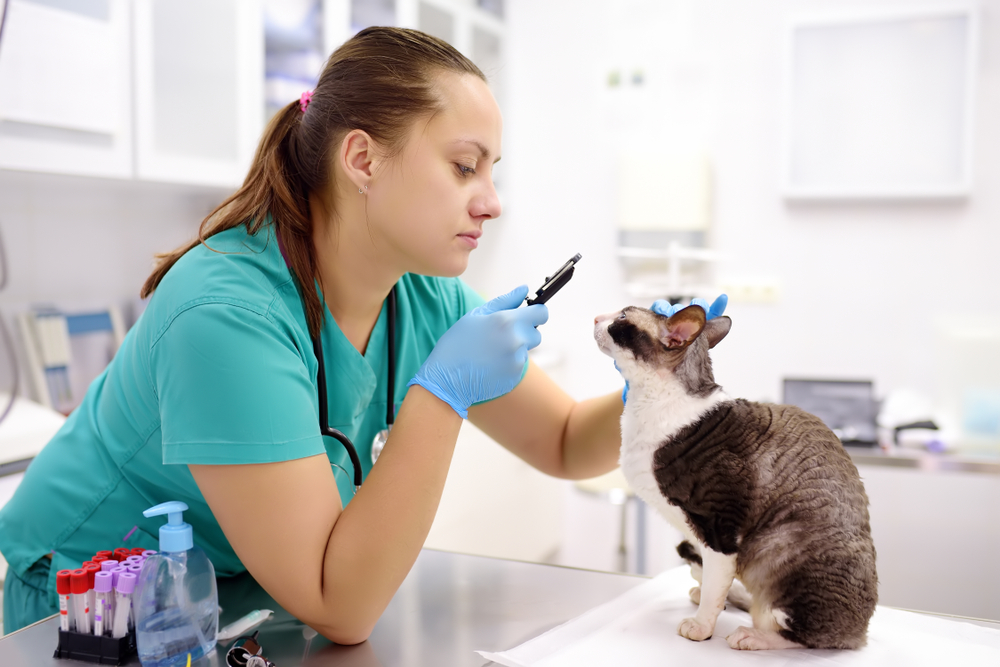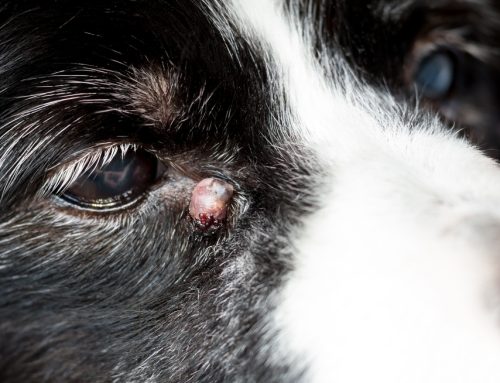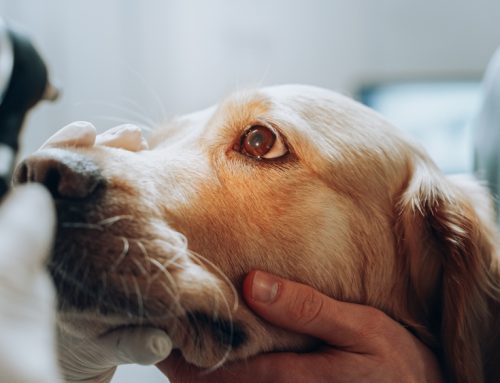If your pet’s facial or eye symmetry has changed, an orbital condition could be to blame. The orbit is the space in which your pet’s eye sits, and provides little extra space for more than than the eye. When lesions, inflammation, or infection invade this area, the eye is displaced and pushed progressively forward.
Too much forward displacement (i.e., exophthalmos) can threaten your pet’s eye health and vision, and usually indicates a larger underlying problem. Any change in your pet’s eye size or position should be promptly evaluated by the Veterinary Vision Center team to find and address the cause. Here are the most common conditions we see in pets with exophthalmos.
#1: Orbital abscess or infection in pets
An orbital abscess is an inflammatory debris pocket behind the eye that pushes the eye forward. An abscess can develop for multiple reasons, including:
- Foreign objects — A pet’s orbit is not completely surrounded by bone as in humans—in pets, the orbit floor is lined with only a thin tissue layer, and foreign objects can enter from the mouth through this tissue. This is most common in young dogs who chew on wood, sticks, or other splintering objects.
- Tooth root infection — Roots from the large upper premolar and molar teeth come close to the orbit, and an abscess or infection in this area can spread into the orbit. Dental abscess can occur from a tooth fracture or periodontal disease.
- Nasal or sinus infection — Infection in the nose or sinuses, adjacent to the orbit, can enter through soft tissue or weakened bone.
- Systemic infection — Some systemic infections, often serious fungal diseases such as blastomycosis or histoplasmosis, can spread through the bloodstream into the orbit.
Diagnosis and treatment first requires a thorough, sedated oral examination to check for dental disease and to create an incision in the mouth to establish orbit drainage and to take a culture, if necessary, to check for bacterial infections. If fungal infection is suspected, blood or urine testing can be helpful. Treatment is aimed at the specific underlying cause and often includes antibiotic and anti-inflammatory medications.

#2: Orbital neoplasia in pets
Orbital neoplasia (i.e., cancer) can look like an abscess, but will not respond to helpful abscess treatments. Sometimes, a tumor extends outside the orbit and is visible on an ophthalmic exam, which can help make the diagnosis. Other times, advanced imaging, such as an ultrasound, CT, or MRI, a tissue biopsy, or an exploratory surgery, may be needed.
Unfortunately, most cancers behind the eye in pets, including lymphoma and sarcomas, are malignant and sometimes aggressive. Tumor removal, usually along with the affected eye, is often recommended, but may not stop the tumor from spreading to other body areas. Orbital tumors can also be secondary to cancers elsewhere in your pet’s body, which indicates that the primary tumor has spread. A veterinary oncologist can help plan the best treatment course for your pet.
#3: Orbital myositis in pets
Orbital myositis is inflammation in the muscles surrounding your pet’s eyes. The eye muscles themselves or nearby head and chewing muscles may be involved. This autoimmune disease—meaning the pet’s immune system mistakenly attacks normal muscle tissue cells—occurs primarily in dogs.
Extraocular muscle myositis has a characteristic appearance with both eyes bulging forward in young, large-breed dogs. Another condition, called masticatory muscle myositis, affects large chewing muscles in the dog’s head and can be diagnosed with a biopsy and/or a specialized blood test. Treatment for both involves long-term immunosuppressive therapy with steroids and other medications.
Other signs related to exophthalmos in pets
A thorough ophthalmic examination can help narrow down exophthalmos causes. In addition to a bulging appearance, pets may also show the following signs, which will give our team clues and point us in the right diagnostic direction:
- Third eyelid elevation
- Pain when opening the mouth, or inability to open the mouth
- Abnormal retropulsion (i.e., the examiner cannot push the eyes backward into the orbit)
- Pain on retropulsion
- Vision loss
- Corneal ulcers secondary to lagophthalmos (i.e., the inability to completely blink)
Most problems that cause exophthalmos in pets are serious, and can threaten your pet’s vision or systemic health. Call us to schedule an appointment with Veterinary Vision Center if you notice any changes to your pet’s eye size, position, or appearance, or their vision. If we determine that your pet needs advanced imaging or other tests, we will work closely with your primary care veterinarian and local specialists to ensure your pet receives the best possible care.







Leave A Comment